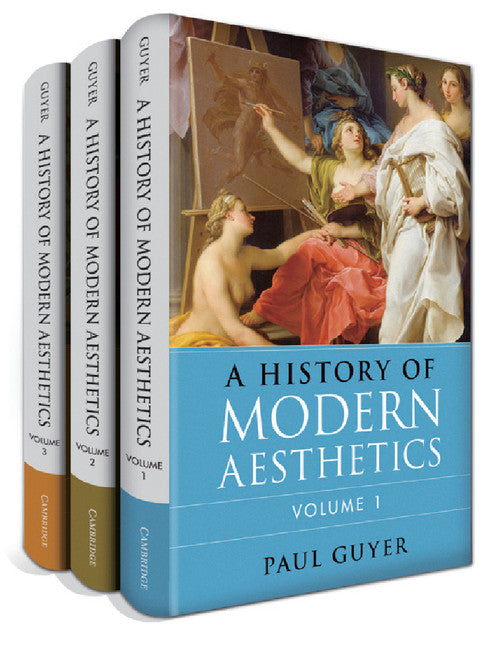Freshly Printed - allow 4 days lead
Couldn't load pickup availability
A History of Modern Aesthetics 3 Volume Set
A History of Modern Aesthetics narrates the history of philosophical aesthetics from the beginning of the eighteenth century through the twentieth century.
Paul Guyer (Author)
9781107643222, Cambridge University Press
Multiple-component retail product, published 10 March 2014
1752 pages
24.3 x 17.2 x 12.7 cm, 2.93 kg
'… Although Guyer is understandably best known for his several decades of Kant scholarship, A History of Modern Aesthetics is his crowning achievement. By embedding aesthetic theory in the history of aesthetics, he has shown the difficulty, but also the essential dignity, of each.' Christopher T. Williams, Philosophy in Review
A History of Modern Aesthetics narrates the history of philosophical aesthetics from the beginning of the eighteenth century through the twentieth century. Aesthetics began with Aristotle's defense of the cognitive value of tragedy in response to Plato's famous attack on the arts in The Republic, and cognitivist accounts of aesthetic experience have been central to the field ever since. But in the eighteenth century, two new ideas were introduced: that aesthetic experience is important because of emotional impact - precisely what Plato criticized - and because it is a pleasurable free play of many or all of our mental powers. This three-volume set tells how these ideas have been synthesized or separated by both the best-known and lesser-known aestheticians of modern times, focusing on Britain, France and Germany in the eighteenth century; Germany and Britain in the nineteenth; and Germany, Britain and the United States in the twentieth.
Volume 1. The Eighteenth Century: 1. Prologue
Part I. Aesthetics in Britain, 1725–1800: 2. Hutcheson to Hume
3. Hogarth, Burke, and Gerard
4. From Kames to Alison and Stewart
Part II. French Aesthetics in Mid-Century: 5. André to Rousseau
Part III. German Aesthetics between Wolff and Kant: 6. The first generation of Wolffian aesthetics
7. German aesthetics at mid-century
8. Coming closer to Kant
Part IV. Kant and After: 9. Kant
10. After Kant. Volume 2. The Nineteenth Century: Part I. German Aesthetics in the First Half of the Nineteenth-Century: 1. Early Romanticism and idealism
2. In the shadow of Schelling
3. The high tide of idealism
4. In the wake of Hegel
Part II. (Mostly) British Aesthetics in the Second Half of the Nineteenth Century: 5. Ruskin
6. Aestheticism
7. Bosanquet and Tolstoy
Part III. German Aesthetics in the Second Half of the Nineteenth Century: 8. In the shadow of Schopenhauer
9. Neo-Kantian aesthetics
10. Psychological aesthetics: play and empathy. Volume 3. The Twentieth Century: Part I. German Aesthetics in the Twentieth Century: 1. German aesthetics between the wars: Lukács and Heidegger
2. German aesthetics after World War II
Part II. Aesthetics in Britain until World War II: 3. Bloomsbury, Croce, and Bullough
4. First responses to Croce
5. Collingwood
Part III. American Aesthetics in the First Half of the Twentieth Century: 6. Santayana
7. The American reception of expression theory I: Parker to Greene
8. Dewey
9. The American reception of expression theory II: Cassirer and Langer
10. After Dewey and Cassirer
Part IV. Wittgenstein and After: Anglo-American Aesthetics in the Second Part of the Twentieth Century: 11. Wittgenstein
12. The first wave
13. The second wave.
Subject Areas: History of ideas [JFCX], Philosophy: aesthetics [HPN], History of Western philosophy [HPC], Literature: history & criticism [DS], History of art & design styles: c 1800 to c 1900 [ACV], History of art & design styles: c 1600 to c 1800 [ACQ]


